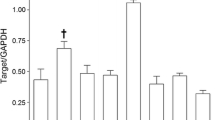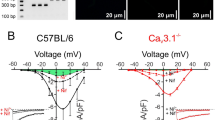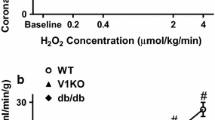Abstract
Previous investigations indicate that diminished functional expression of voltage-dependent K+ (KV) channels impairs control of coronary blood flow in obesity/metabolic syndrome. The goal of this investigation was to test the hypothesis that KV channels are electromechanically coupled to CaV1.2 channels and that coronary microvascular dysfunction in obesity is related to subsequent increases in CaV1.2 channel activity. Initial studies revealed that inhibition of KV channels with 4-aminopyridine (4AP, 0.3 mM) increased intracellular [Ca2+], contracted isolated coronary arterioles and decreased coronary reactive hyperemia. These effects were reversed by blockade of CaV1.2 channels. Further studies in chronically instrumented Ossabaw swine showed that inhibition of CaV1.2 channels with nifedipine (10 μg/kg, iv) had no effect on coronary blood flow at rest or during exercise in lean swine. However, inhibition of CaV1.2 channels significantly increased coronary blood flow, conductance, and the balance between coronary flow and metabolism in obese swine (P < 0.05). These changes were associated with a ~50 % increase in inward CaV1.2 current and elevations in expression of the pore-forming subunit (α1c) of CaV1.2 channels in coronary smooth muscle cells from obese swine. Taken together, these findings indicate that electromechanical coupling between KV and CaV1.2 channels is involved in the regulation of coronary vasomotor tone and that increases in CaV1.2 channel activity contribute to coronary microvascular dysfunction in the setting of obesity.






Similar content being viewed by others
References
Bache RJ, Quanbeck D, Homans DC, Dai XZ (1987) Effects of nifedipine on coronary reactive and exercise induced hyperaemia. Cardiovasc Res 21:766–771. doi:10.1093/cvr/21.10.766
Barbar E, Rola-Pleszczynski M, Payet MD, Dupuis G (2003) Protein kinase C inhibits the transplasma membrane influx of Ca2+ triggered by 4-aminopyridine in Jurkat T lymphocytes. Biochim Biophys Acta 1622:89–98. doi:10.1016/S0304-4165(03)00120-X
Belin de Chantemele EJ, Ali MI, Mintz J, Stepp DW (2009) Obesity induced-insulin resistance causes endothelial dysfunction without reducing the vascular response to hindlimb ischemia. Basic Res Cardiol 104:707–717. doi:10.1007/s00395-009-0042-2
Bender SB, Tune JD, Borbouse L, Long X, Sturek M, Laughlin MH (2009) Altered mechanism of adenosine-induced coronary arteriolar dilation in early-stage metabolic syndrome. Exp Biol Med (Maywood) 234:683–692. doi:10.3181/0812-RM-350
Berwick ZC, Dick GM, Moberly SP, Kohr MC, Sturek M, Tune JD (2011) Contribution of voltage-dependent K(+) channels to metabolic control of coronary blood flow. J Mol Cell Cardiol 52:912–919. doi:10.1016/j.yjmcc.2011.07.004
Berwick ZC, Dick GM, Tune JD (2011) Heart of the matter: coronary dysfunction in metabolic syndrome. J Mol Cell Cardiol 52:848–856. doi:10.1016/j.yjmcc.2011.06.025
Berwick ZC, Moberly SP, Kohr MC, Morrical EB, Kurian MM, Dick GM, Tune JD (2012) Contribution of voltage-dependent K+ and Ca2+ channels to coronary pressure-flow autoregulation. Basic Res Cardiol 107:264. doi:10.1007/s00395-012-0264-6
Berwick ZC, Payne GA, Lynch B, Dick GM, Sturek M, Tune JD (2010) Contribution of adenosine A(2A) and A(2B) receptors to ischemic coronary dilation: role of K(V) and K(ATP) channels. Microcirculation 17:600–607. doi:10.1111/j.1549-8719.2010.00054.x
Borbouse L, Dick GM, Payne GA, Berwick ZC, Neeb ZP, Alloosh M, Bratz IN, Sturek M, Tune JD (2010) Metabolic syndrome reduces the contribution of K+ channels to ischemic coronary vasodilation. Am J Physiol Heart Circ Physiol 298:H1182–H1189. doi:10.1152/ajpheart.00888.2009
Borbouse L, Dick GM, Asano S, Bender SB, Dincer UD, Payne GA, Neeb ZP, Bratz IN, Sturek M, Tune JD (2009) Impaired function of coronary BK(Ca) channels in metabolic syndrome. Am J Physiol Heart Circ Physiol 297:H1629–H1637. doi:10.1152/ajpheart.00466.2009
Borbouse L, Dick GM, Payne GA, Payne BD, Svendsen MC, Neeb ZP, Alloosh M, Bratz IN, Sturek M, Tune JD (2009) Contribution of BKCa channels to local metabolic coronary vasodilation: effects of metabolic syndrome. Am J Physiol Heart Circ Physiol 298:H966–H973. doi:10.1152/ajpheart.00876.2009
Bowles DK, Heaps CL, Turk JR, Maddali KK, Price EM (2004) Hypercholesterolemia inhibits L-type calcium current in coronary macro-, not microcirculation. J Appl Physiol 96:2240–2248. doi:10.1152/japplphysiol.01229.2003
Bowles DK, Maddali KK, Ganjam VK, Rubin LJ, Tharp DL, Turk JR, Heaps CL (2004) Endogenous testosterone increases L-type Ca2+ channel expression in porcine coronary smooth muscle. Am J Physiol Heart Circ Physiol 287:H2091–H2098. doi:10.1152/ajpheart.00258.2004
Bratz IN, Dick GM, Tune JD, Edwards JM, Neeb ZP, Dincer UD, Sturek M (2008) Impaired capsaicin-induced relaxation of coronary arteries in a porcine model of the metabolic syndrome. Am J Physiol Heart Circ Physiol 294:H2489–H2496. doi:10.1152/ajpheart.01191.2007
del Carmen GM, Torres M, Sanchez-Prieto J (2005) The modulation of Ca2+ and K+ channels but not changes in cAMP signaling contribute to the inhibition of glutamate release by cannabinoid receptors in cerebrocortical nerve terminals. Neuropharmacology 48:547–557. doi:10.1016/j.neuropharm.2004.11.012
Dick GM, Bratz IN, Borbouse L, Payne GA, Dincer UD, Knudson JD, Rogers PA, Tune JD (2008) Voltage-dependent K+ channels regulate the duration of reactive hyperemia in the canine coronary circulation. Am J Physiol Heart Circ Physiol 294:H2371–H2381. doi:10.1152/ajpheart.01279.2007
Dick GM, Tune JD (2010) Role of potassium channels in coronary vasodilation. Exp Biol Med (Maywood) 235:10–22. doi:10.1258/ebm.2009.009201
Dincer UD, Araiza AG, Knudson JD, Molina PE, Tune JD (2006) Sensitization of coronary alpha-adrenoceptor vasoconstriction in the prediabetic metabolic syndrome. Microcirculation 13:587–595. doi:10.1080/10739680600885228
Fan ZW, Zhang ZX, Xu YJ (2004) Inhibition of voltage-gated K+ current in rat intrapulmonary arterial smooth muscle cells by endothelin-1. Yao Xue Xue Bao 39:9–12
Fink RH, Stephenson DG (1987) Ca2+ -movements in muscle modulated by the state of K+-channels in the sarcoplasmic reticulum membranes. Pflugers Arch 409:374–380. doi:10.1007/BF00583791
Grimaldi M, Atzori M, Ray P, Alkon DL (2001) Mobilization of calcium from intracellular stores, potentiation of neurotransmitter-induced calcium transients, and capacitative calcium entry by 4-aminopyridine. J Neurosci 21:3135–3143
Heusch G, Deussen A (1984) Nifedipine prevents sympathetic vasoconstriction distal to severe coronary stenoses. J Cardiovasc Pharmacol 6:378–383
Heusch G, Guth BD, Seitelberger R, Ross J Jr (1987) Attenuation of exercise-induced myocardial ischemia in dogs with recruitment of coronary vasodilator reserve by nifedipine. Circulation 75:482–490
Jaggar JH, Porter VA, Lederer WJ, Nelson MT (2000) Calcium sparks in smooth muscle. Am J Physiol Cell Physiol 278:C235–C256
Jones SW (2003) Calcium channels: unanswered questions. J Bioenerg Biomembr 35:461–475. doi:10.1023/B:JOBB.0000008020.86004.28
Knudson JD, Dincer UD, Bratz IN, Sturek M, Dick GM, Tune JD (2007) Mechanisms of coronary dysfunction in obesity and insulin resistance. Microcirculation 14:317–338. doi:10.1080/10739680701282887
Kubo T, Taguchi K, Ueda M (1998) L-type calcium channels in vascular smooth muscle cells from spontaneously hypertensive rats: effects of calcium agonist and antagonist. Hypertens Res 21:33–37. doi:10.1291/hypres.21.33
Lassaletta AD, Chu LM, Robich MP, Elmadhun NY, Feng J, Burgess TA, Laham RJ, Sturek M, Sellke FW (2012) Overfed Ossabaw swine with early stage metabolic syndrome have normal coronary collateral development in response to chronic ischemia. Basic Res Cardiol 107:243. doi:10.1007/s00395-012-0243-y
Mandegar M, Yuan JX (2002) Role of K+ channels in pulmonary hypertension. Vascul Pharmacol 38:25–33
McCarty MF (2006) PKC-mediated modulation of L-type calcium channels may contribute to fat-induced insulin resistance. Med Hypotheses 66:824–831. doi:10.1016/j.mehy.2004.08.034
Miller SJ, Norton LE, Murphy MP, Dalsing MC, Unthank JL (2007) The role of the renin-angiotensin system and oxidative stress in spontaneously hypertensive rat mesenteric collateral growth impairment. Am J Physiol Heart Circ Physiol 292:H2523–H2531. doi:10.1152/ajpheart.01296.2006
Murthy VL, Naya M, Foster CR, Gaber M, Hainer J, Klein J, Dorbala S, Blankstein R, Di Carli MF (2012) Association between coronary vascular dysfunction and cardiac mortality in patients with and without diabetes mellitus. Circulation 126:1858–1868. doi:10.1161/CIRCULATIONAHA.112.120402
Nelson MT, Patlak JB, Worley JF, Standen NB (1990) Calcium channels, potassium channels, and voltage dependence of arterial smooth muscle tone. Am J Physiol 259:C3–18
Nelson MT, Standen NB, Brayden JE, Worley JF III (1988) Noradrenaline contracts arteries by activating voltage-dependent calcium channels. Nature 336:382–385. doi:10.1038/336382a0
Park WS, Firth AL, Han J, Ko EA (2010) Patho-, physiological roles of voltage-dependent K+ channels in pulmonary arterial smooth muscle cells. J Smooth Muscle Res 46:89–105. doi:10.1540/jsmr.46.89
Payne GA, Borbouse L, Kumar S, Neeb Z, Alloosh M, Sturek M, Tune JD (2010) Epicardial perivascular adipose-derived leptin exacerbates coronary endothelial dysfunction in metabolic syndrome via a protein kinase C-beta pathway. Arterioscler Thromb Vasc Biol 30:1711–1717. doi:10.1161/ATVBAHA.110.210070
Pesic A, Madden JA, Pesic M, Rusch NJ (2004) High blood pressure upregulates arterial L-type Ca2+ channels: is membrane depolarization the signal? Circ Res 94:e97–104. doi:10.1161/01.RES.0000131495.93500.3c
Pratt PF, Bonnet S, Ludwig LM, Bonnet P, Rusch NJ (2002) Upregulation of L-type Ca2+ channels in mesenteric and skeletal arteries of SHR. Hypertension 40:214–219. doi:10.1161/01.HYP.0000025877.23309.36
Ryan D, Drysdale AJ, Lafourcade C, Pertwee RG, Platt B (2009) Cannabidiol targets mitochondria to regulate intracellular Ca2+ levels. J Neurosci 29:2053–2063. doi:10.1523/JNEUROSCI.4212-08.2009
Saitoh S, Zhang C, Tune JD, Potter B, Kiyooka T, Rogers PA, Knudson JD, Dick GM, Swafford A, Chilian WM (2006) Hydrogen peroxide: a feed-forward dilator that couples myocardial metabolism to coronary blood flow. Arterioscler Thromb Vasc Biol 26:2614–2621. doi:10.1161/01.ATV.0000249408.55796.da
Setty S, Sun W, Martinez R, Downey HF, Tune JD (2004) Alpha-adrenoceptor-mediated coronary vasoconstriction is augmented during exercise in experimental diabetes mellitus. J Appl Physiol 97:431–438. doi:10.1152/japplphysiol.01122.2003
Thorneloe KS, Nelson MT (2005) Ion channels in smooth muscle: regulators of intracellular calcium and contractility. Can J Physiol Pharmacol 83:215–242. doi:10.1139/Y05-016
Wellman GC, Nelson MT (2003) Signaling between SR and plasmalemma in smooth muscle: sparks and the activation of Ca2+ -sensitive ion channels. Cell Calcium 34:211–229. doi:10.1016/S0143-4160(03)00124-6
Witczak CA, Wamhoff BR, Sturek M (2006) Exercise training prevents Ca2+ dysregulation in coronary smooth muscle from diabetic dyslipidemic Yucatan swine. J Appl Physiol 101:752–762. doi:10.1152/japplphysiol.00235.2006
Wood PG, Gillespie JI (1998) In permeabilised endothelial cells IP3-induced Ca2+ release is dependent on the cytoplasmic concentration of monovalent cations. Cardiovasc Res 37:263–270. doi:10.1016/S0008-6363(97)00207-1
Yuan JX, Aldinger AM, Juhaszova M, Wang J, Conte JV Jr, Gaine SP, Orens JB, Rubin LJ (1998) Dysfunctional voltage-gated K+ channels in pulmonary artery smooth muscle cells of patients with primary pulmonary hypertension. Circulation 98:1400–1406
Acknowledgments
This work was supported by AHA grants 10PRE4230035 (ZCB) and NIH grants HL092245 (JDT), HL115140 (JDT and AGO), T32DK007519; O’Leary (HB), T32HL079995; Goodwill (KM), and T32DK064466; Owen (PR).
Conflict of interest
The authors have no conflicts to disclose.
Author information
Authors and Affiliations
Corresponding author
Electronic supplementary material
Below is the link to the electronic supplementary material.
Rights and permissions
About this article
Cite this article
Berwick, Z.C., Dick, G.M., O’Leary, H.A. et al. Contribution of electromechanical coupling between KV and CaV1.2 channels to coronary dysfunction in obesity. Basic Res Cardiol 108, 370 (2013). https://doi.org/10.1007/s00395-013-0370-0
Received:
Revised:
Accepted:
Published:
DOI: https://doi.org/10.1007/s00395-013-0370-0




